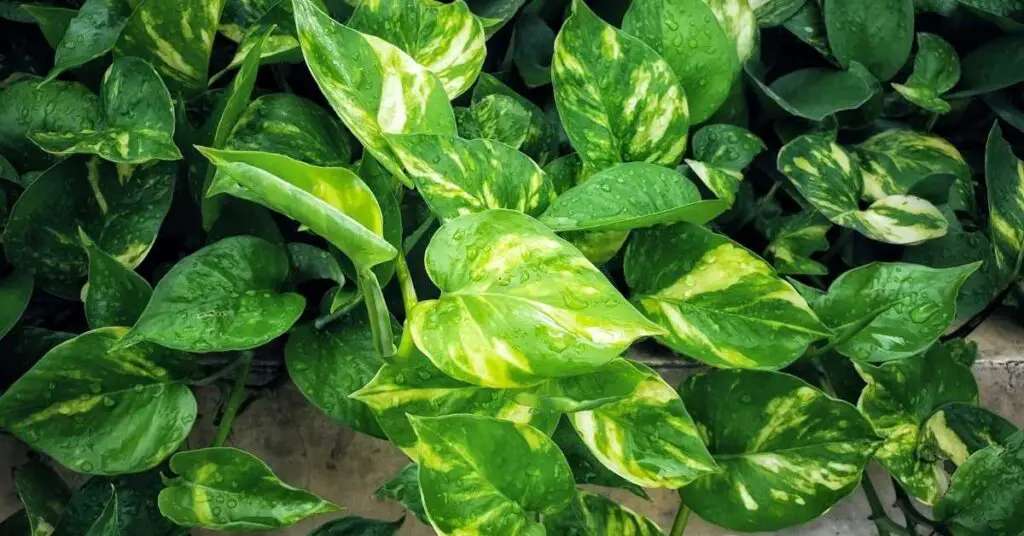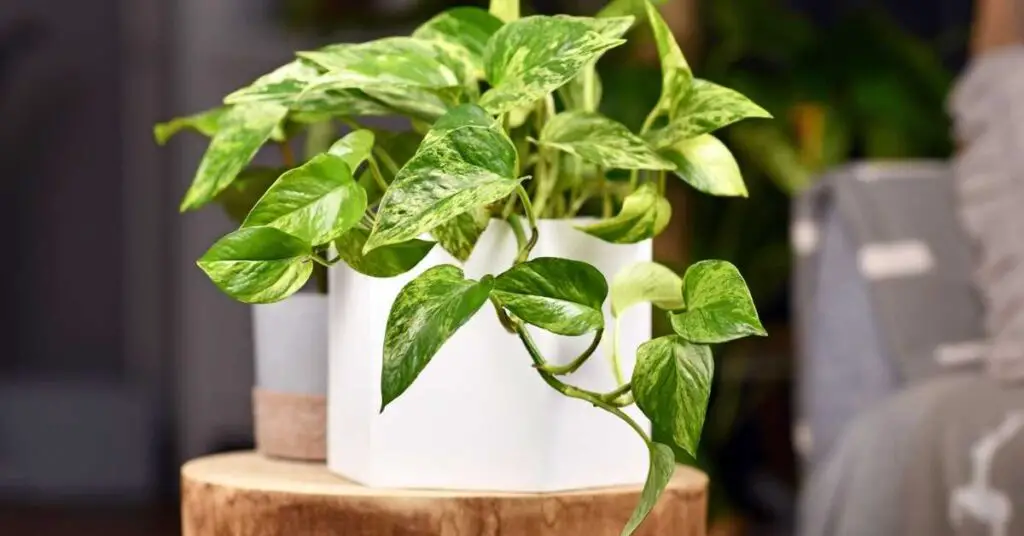Why Are My Pothos Leaves Turning Black? There are several reasons that your pothos leaves are turning black. This could be a sign of the plant not getting enough light, water, or even food. The best thing to do is to reevaluate where you are keeping your pothos plant and how often you are watering and feeding it. Once you have examined these things then you can make adjustments if needed.
Are you a proud pothos plant owner, but recently noticed that your plant’s leaves are turning black? Don’t worry, you’re not alone.
Pothos plants are popular among plant enthusiasts due to their easy-going nature, but they still require proper care and attention to thrive. Blackened leaves can indicate a variety of issues, and it’s important to identify the cause and take action to prevent further damage.
In this article, we’ll explore the common reasons why pothos leaves turn black, including overwatering, poor drainage, inadequate lighting, pests, and diseases.
We’ll also provide tips on proper pruning techniques and preventative measures to ensure your pothos plant stays healthy and vibrant. So, let’s dive in and learn how to give your pothos the care it needs to thrive.
Understanding Pothos Plant Care
You’ll learn the essential tips and tricks for caring for your Pothos plant, ensuring it grows healthy and vibrant.
One of the first things to consider is whether you have an indoor or outdoor Pothos plant. Indoor Pothos plants require different care than outdoor ones, so it’s important to know which one you have.
Indoor Pothos plants thrive in bright but indirect sunlight, while outdoor Pothos plants need more direct sunlight. Common mistakes made with Pothos plant care include overwatering, underwatering, and not providing enough light.
Overwatering can lead to root rot, which can cause blackening of the leaves. On the other hand, underwatering can cause the leaves to dry out and turn brown. It’s important to find the right balance of water and light for your Pothos plant.
Another mistake is not fertilizing the plant regularly. Pothos plants need nutrients to thrive, so make sure to fertilize every two weeks during the growing season. To keep your Pothos plant healthy and prevent the blackening of the leaves, make sure to provide adequate water, light, and nutrients.
Keep the soil moist but not waterlogged, and make sure to provide indirect sunlight. If your plant is getting too much light, move it to a shadier spot. Regular fertilizing can also help keep your Pothos plant healthy and vibrant.
With proper care, your Pothos plant can thrive for years to come.

Identifying Blackened Leaves
Identifying the blackened foliage on your pothos plant is crucial in determining the cause and finding a solution to prevent further damage. There are several causes of discoloration, which include overwatering, lack of sunlight, and exposure to extreme temperatures.
It’s essential to examine the leaves and look for any other signs of damage, such as yellowing, wilting, or browning. Treatment options depend on the cause of the blackened leaves. If the plant is overwatered, allow the soil to dry out before watering again.
If the plant isn’t getting enough sunlight, move it to a brighter location. If the plant is exposed to extreme temperatures, move it away from windows or doors. Additionally, you can prune the damaged leaves to encourage new growth and prevent further damage.
In some cases, blackened leaves may be a sign of a more severe issue, such as root rot or a fungal infection. If the problem persists, consider repotting the plant in fresh soil or using a fungicide to treat the issue.
Remember, the key to preventing blackened leaves on your pothos plant is to provide it with the appropriate care, including regular watering, sufficient sunlight, and proper temperature control.
Overwatering and Poor Drainage
If you’re noticing a foul smell coming from your plant and the soil is consistently wet, it’s possible that you’re overwatering and the poor drainage is causing serious damage to your beloved green friend.
Pothos thrive in moist soil, but too much water can lead to root rot, which can eventually cause the leaves to turn black and die.
To avoid overwatering, make sure to allow the soil to dry out completely before watering again. Choosing the right potting soil can also help with drainage issues. When selecting potting soil for your pothos, opt for a mix that contains perlite or vermiculite. These materials help to improve drainage and prevent water from getting trapped in the soil.
Additionally, make sure that the pot you’re using has drainage holes to allow excess water to escape. If you’re having trouble with drainage, try adding a layer of gravel or rocks to the bottom of the pot before adding the soil.
It’s important to remember that overwatering and poor drainage are common issues that can affect any indoor plant, not just pothos. By paying attention to the moisture levels in the soil and making sure that your plant is getting adequate drainage, you can help to prevent blackened leaves and other problems that can threaten the health of your greenery.
So, keep a watchful eye on your pothos and adjust your watering routine and soil as needed to keep it happy and healthy.
Inadequate Lighting
I’ve noticed that when you don’t give your indoor plants enough light, they start to look a little sad and droopy. This can happen to your pothos plant as well. Pothos plants thrive in bright, indirect light, but they can also tolerate lower light conditions. However, if they don’t get enough light, their leaves may start turning black.
To prevent your pothos leaves from turning black due to inadequate lighting, here are a few things you can do:
- Place your pothos plant near a window that receives plenty of natural light. However, be careful not to expose it to direct sunlight, as this can scorch the leaves.
- If you don’t have access to natural light, you can use artificial light to supplement your pothos plant’s needs. LED grow lights are a great option, as they’re energy-efficient and provide the right spectrum of light for plant growth.
- Rotate your pothos plant every few days to ensure that all sides of the plant receive enough light. Otherwise, the leaves on one side may start turning black while the other side remains healthy.
- If you notice that your pothos plant’s leaves are turning black despite your best efforts, consider moving it outdoors for a few hours a day. This can help it get the sunlight it needs to thrive.
Remember, a healthy pothos plant has green, glossy leaves. If you notice that your plant’s leaves are turning black, it’s time to examine the lighting conditions and make adjustments. With a little care and attention, you can help your pothos plant thrive and add a touch of greenery to your home.
Pests and Diseases
To keep your pothos plant healthy, you’ll need to watch out for pests and diseases that can harm it.
Common pests that can affect pothos plants include spider mites, mealybugs, and scale insects. These pests tend to suck the sap from the leaves, resulting in discolored and damaged leaves.
If you notice small webs on your plant or tiny white spots, you may have a spider mite or mealybug infestation. Scale insects, on the other hand, can be identified by their small, waxy shells that appear on the leaves.
Another factor that can cause black leaves on your pothos plant is fungal infections. Fungal infections can cause the leaves to turn black and die.
If you notice black spots on the leaves of your pothos plant, it may be a sign of fungal infection. Fungal infections can be caused by overwatering, poor drainage, and high humidity levels.
To prevent fungal infections, make sure your plant is not overwatered and has proper drainage. You can also improve air circulation around your plant, which will help reduce humidity levels.
If you suspect that your pothos plant has a pest or disease problem, it’s important to act quickly. Pests and diseases can spread quickly and cause irreversible damage to your plant.
The first step is to isolate your plant and carefully examine it for signs of pests or diseases. You can then treat the problem using natural or chemical methods.
You can use insecticidal soap or neem oil to control pests, while copper or sulfur-based fungicides are effective in treating fungal infections.
With proper care and attention, your pothos plant will thrive and remain healthy.
Proper Pruning Techniques
You’ll be surprised to learn that cutting off parts of your beloved pothos plant can actually help it grow better – that’s right, we’re talking about proper pruning techniques!
Pruning is an essential part of pothos plant care as it helps the plant grow new shoots and leaves. When you prune your pothos, you’re encouraging it to grow bushier and fuller, which results in a healthier and more attractive plant.
To start, you’ll need a pair of sharp and clean pruning shears. The best time to prune your pothos is during the growing season, which is typically in the spring or summer.
Identify the stems that are overgrown, damaged, or yellowing, and cut them off at the base of the stem. It’s also a good idea to prune any leggy or sparse stems as this will encourage the plant to grow more evenly.
Don’t forget to propagate the cuttings you’ve taken! Pothos plants are easy to propagate, and you can use the cuttings to create new plants. Simply place the cuttings in water, and once the roots have grown, you can transplant them into the soil.
Proper pruning and propagation methods, along with regular fertilization tips, will ensure that your pothos plant stays healthy and happy for years to come.

Preventing Future Leaf Damage
If you want to keep your plant looking lush and vibrant, it’s important to take preventative measures to avoid future leaf damage.
Pothos plants are relatively easy to care for, but they can still fall victim to various issues if not properly maintained. Luckily, there are several simple steps you can take to prevent black leaves on your pothos plant.
First and foremost, root rot prevention is key. Overwatering is one of the most common causes of root rot in pothos plants. To avoid this problem, make sure your plant’s soil is well-draining and not sitting in standing water. Additionally, only water your pothos when the top inch of soil feels dry to the touch.
Proper watering techniques will help keep your plant healthy and prevent future leaf damage.
Another important preventative measure is nutrient deficiency management. Pothos plants require regular fertilization to thrive, but too much or too little can cause issues. Be sure to use a balanced fertilizer specifically formulated for houseplants, and follow the package instructions for application.
Additionally, consider repotting your pothos every year or two to refresh the soil and provide fresh nutrients for your plant.
By taking these preventative measures, you can help ensure a healthy and vibrant pothos plant.
Frequently Asked Questions
Can pothos plants survive in low temperatures?
Did you know that pothos plants can survive in temperatures as low as 50 degrees Fahrenheit? That’s right!
These popular houseplants have developed survival strategies that allow them to tolerate a wide range of temperatures. Pothos plants have the ability to slow down their growth and conserve energy when exposed to cooler temperatures.
However, it’s important to note that prolonged exposure to low temperatures can still be detrimental to their health. To ensure the best chance of survival, it’s recommended to keep your pothos plant in a temperature-controlled environment that ranges from 65-85 degrees Fahrenheit.
How often should I fertilize my pothos plant?
To keep your pothos plant thriving, it’s essential to fertilize it regularly. Using organic fertilizers can provide numerous benefits to your plant, including promoting healthy growth and preventing nutrient deficiencies.
When applying fertilizer, make sure to follow proper techniques such as diluting the fertilizer and avoiding overwatering. By doing so, you’ll ensure that your pothos plant receives the nutrients it needs for optimal health and vitality.
Plus, being a plant parent is a rewarding experience, and giving your pothos the care it needs can help you feel a sense of belonging to the plant-loving community.
Can I propagate my pothos plant from blackened leaves?
Looking to expand your pothos plant collection? Propagation techniques are an excellent way to achieve this goal.
Pruning methods can be used to create new plants from existing ones, even if the leaves are blackened. While blackened leaves may indicate an underlying issue with the plant’s health, they can still be used for propagation purposes.
By cutting the healthy parts of the stem and placing them in water or soil, you can create new pothos plants to add to your collection. Whether you’re a seasoned plant parent or just starting out, propagating pothos plants is a great way to feel a sense of belonging in the plant community.
Is it safe to use tap water for watering my pothos plant?
When it comes to watering your pothos plant, you may be wondering if tap water is safe to use. The truth is, the quality of tap water varies depending on your location and the source of your water.
Some tap water contains chemicals like chlorine and fluoride that can be harmful to your pothos plant over time. While tap water is generally safe for human consumption, it’s a good idea to consider alternative options for your pothos plant.
You may want to try using filtered water, rainwater, or distilled water to ensure that your plant gets the best possible care. By taking these extra steps, you can help your pothos plant thrive and give it the care it deserves.
How long does it take for a pothos plant to recover from blackened leaves?
If you’ve noticed blackened leaves on your pothos plant, don’t panic. While it’s not an ideal situation, it’s not the end of the world either.
Pruning strategies are a great way to help your plant recover, as they can help remove any damaged or dead leaves. It’s also important to take preventative measures to ensure that your plant doesn’t suffer the same fate in the future.
For example, make sure your pothos is not overwatered or exposed to too much direct sunlight. With a little bit of patience and care, your pothos should be able to recover from blackened leaves in no time.
Conclusion
So, you’ve learned about the various reasons why your pothos leaves are turning black. Now what? Don’t fret, there are solutions!
Think of your pothos plant as a delicate dance partner, with you leading the way. Just like a dance, it takes time and practice to perfect the steps. By understanding the basics of pothos plant care, identifying the causes of blackened leaves, and implementing preventative measures, you can keep your pothos thriving.
Remember, caring for your pothos is like a graceful waltz – take it slow, step by step, and enjoy the beautiful rhythm of growth.



